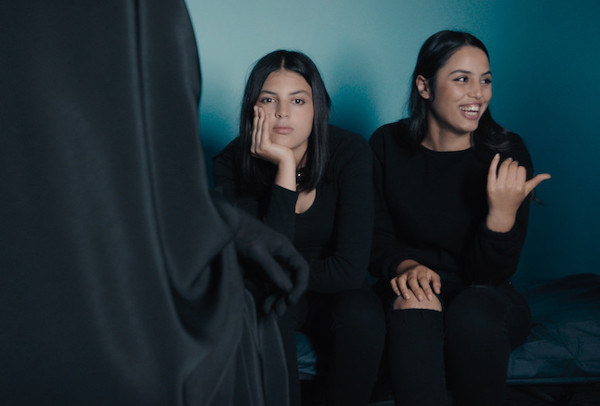Film Review: “Four Daughters” — Young Womanhood and Trauma, Experienced and Inherited
By Neil Giordano
Four Daughters calls attention to the complex and admittedly slippery nature of nonfiction filmmaking.
Four Daughters is screening at The Brattle Theatre from March 1 through 4. It is also available to rent on various platforms and by subscription via the new Kino Now streaming service.

A scene from the documentary Four Daughters.
Reenactments have been a staple of the tradition of documentary film since the genre’s inception a century or so ago. As far back as Nanook of the North, fictionalized or otherwise play-acted scenes presented as “nonfiction” have generated controversy, including charges of exploitation. A new wave of contemporary filmmakers has embraced the technique, but they are taking it in ingenious and often paradoxical directions. The strategy is to include elaborately scripted scenes featuring professional actors that draw attention to the artifice of their own making. This meta approach to documentary often bears provocative fruit because it calls attention to the complex and admittedly slippery nature of nonfiction filmmaking. Tunisian director Kaouther Ben Hania’s Four Daughters, among this year’s Oscar nominees for Best Documentary, is a prime example of the form.
The film opens with an almost fairy tale-like piece of cinematic storytelling. We first meet Olfa, the stern-faced mother of the eponymous daughters, and the two youngest daughters, Eya and Tayssir. Then we are told, portentously, that the other two daughters were “devoured by the wolf.” The film takes a circuitously suspenseful route as it reveals (eventually) just who or what the wolf was. Along the way we learn a lot about the family. The dynamic of this matriarchal clan is closely probed, revealing undercurrents of intermingled love, sisterhood, and rage. But these individual stories open onto larger truths about the phenomenon of inherited trauma, the contradictions of female sexuality in a Muslim culture, and the pull of freedom and religious radicalization for young women in Tunisia and the Arab world.
To explore these issues, director Ben Hania (never seen herself, but heard offscreen) hired actresses to play the two missing daughters, as well as an actress to play Olfa, purportedly to appear in scenes that, the director tells the real Olfa, are too “difficult” to reenact. The film then interweaves, sometimes dizzyingly, a series of set pieces from Olfa’s and the girls’ individual and collective pasts: Olfa’s wedding night with her now-estranged husband and the girls’ father; a surreal chorus of pro-Tunisia propaganda chants by the girls, who are bedecked in red majorette outfits; a daughter’s brief flirtation with a boy interrupted by the entrance of an angry Olfa. Many of these scenes devolve into unscripted conversations about old wounds that have been reopened. The two (real) daughters contemplate and relitigate the past, reconsidering these painful episodes as young adults. Often, the viewer is left uncertain about where a set piece ends and meditations on reality begin; this rich ambiguity conflates past and present, child and adult, anger and blame. Interspersed into the mix are straight interviews that tease us about the whereabouts of the two missing daughters, which is revealed in the final act.

A scene from Four Daughters.
A compelling feature of Four Daughters is the use of the same actor, Majd Mastoura, to play nearly all of the male roles: the father, an abusive boyfriend of Olfa’s, a policeman. The film’s universe takes place almost entirely in the realm of women. The casting choice suggests the ambiguous power of maleness and patriarchy: perilous and fraught with contempt for women, yet also alluring and desirable. Men are inextricable from the story yet they are also marginalized and occasionally ridiculed. Their presence — in front of and behind the camera — is used to underline one of Ben Hania’s major points. In various fourth-wall breaking moments, Olfa is horrified that the girls are discussing taboo subjects — such as female anatomy and menstruation — in the presence of a man (the cinematographer). The girls laugh it off (“He’s just doing his job”), dramatizing a generational divide that sets off undercurrents of tension that never completely separate the mother from her daughters (real or otherwise). The daughters’ honesty — they swear openly and talk about their bodies — turns out to be a key to bringing up and resolving cultural problems.
The meta-theatrical devices begin to lose their power as the film winds down, maybe the result of the inevitable dominance of reality. Perhaps it is also driven by our curiosity about the two elder daughters’ fate. Slowly but surely expressions of rage within and among the family members grow during the reenactments and the purely nonfictional scenes. Near the end of a set piece, Tayssir openly speaks of her anger at her mother’s emotional abuse: “The film makes it easier to say these things.” How much of the family’s traumatized situation stems from Olfa’s toxic attitudes, her control over her daughters’ sexuality and freedom? For all its criticism of the patriarchy, does Four Daughters vindicate or condemn the mother for what happened to the family? The film leaves this and other questions tantalizingly open.
Neil Giordano teaches film and creative writing in Newton. His work as an editor, writer, and photographer has appeared in Harper’s, Newsday, Literal Mind, and other publications. Giordano previously was on the original editorial staff of DoubleTake magazine and taught at the Center for Documentary Studies at Duke University.
Tagged: 2012 Oscar DOCUMENTARY, Ben Hania, documentary, Four Daughters, Kaouther Ben Hania, patriarchy
